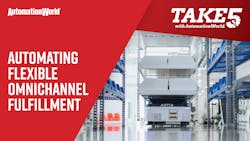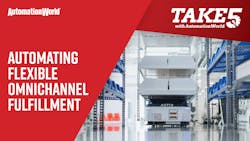Quick hits:
- ABB acquires ASTI Mobile Robotics Group, expanding automation portfolio for logistics and distribution.
- Omnichannel fulfillment requires autonomous mobile robots for intelligent material flow at warehouse distribution centers.
- At PACK EXPO Las Vegas 2021, ABB demonstrated what an automated, flexible omnichannel fulfillment center would look like.
- ABB Acquires ASTI Mobile Robotics Group
- Mobile Robots Make an Impact on Omnichannel Fulfillment
- PELV 2021 Video: ABB's Automated Omnichannel Fulfillment
- Visit PMMI's Business Intelligence Library and download their executive summaries of their latest reports for free
Stephanie Neil: Welcome to Take Five with Automation World, I’m Stephanie Neil reporting today on some of the latest news that impacts how manufacturers can respond to new consumer buying behavior.
Specifically, the multichannel approach to sales, known as the omnichannel, which meets customers wherever they are buying—in the store, online, or both, because you may order something on your phone and pick it up in the store. While that’s great for you and me, it’s a logistical nightmare for the CPG.
In order to deliver products to the right channel, the warehouse needs flexible material flow. To date, that’s been pretty hard to do with stationary robots that are palletizing, depalletizing, and sorting.
So, ABB, a company that has been growing its portfolio in the robotics and machine control areas, recently made another strategic move. In July, it announced the acquisition of ASTI Mobile Robotics Group. Based in Spain, ASTI is a provider of autonomous mobile robots, known as AMRs, which include software for navigation, fleet management, and cloud-based traceability.
ABB executives call this acquisition a gamechanger as it, first, positions ABB as a company that can deliver a full automation portfolio of control, robotics, and even power and electrical equipment. For manufacturers, it provides an option for intelligent material flow, which can’t be handled by conveyors alone.
So, in September, at PACK EXPO Las Vegas, ABB demonstrated what a flexible omnichannel fulfillment center would look like, and how the company’s technology can help in all aspects, including filling small batch orders that are personalized to the consumer’s preference.
Automation World's David Greenfield spoke with ABB at PACK EXPO and was given a demonstration of how this fully automated distribution center would work. Let’s take a look.
Rick Ankey: I'm showing you the flexible omnichannel. So, to come up with automation to meet the needs of customers, consumers that are purchasing now direct-to-consumer business, people want to buy things and have them delivered to their house. They want to buy things, have them picked up at a store, and they want to buy things still from their store so they end up through the logistics in the retail space.
I wanted to show you an example of a father buying presents and gifts and things for a birthday party for his son, Alex. As I mentioned, people want to buy individualized custom packages, so it's small-batch orders, personalization. And so, here, you see this father picking some things for his birthday party. They're blue, red, green. And, when I say personalized, he puts his son's Alex's name on there.
Now, this is difficult for traditional warehouse distribution centers to handle. So, what we're proposing is an omnichannel fulfillment center that's highly automated with robotics. This is our IRB 390. It's got a fifth-axis flip. It also has a heavy payload, like 15 kg payload. The fifth-axis version has a 10 kg payload and onto an ABB B&R track. This is called the occupods track, and you can see that the personalization is there.
Next, we're using the IRB 390, which is a new robot for ABB, to do the packaging. You can see the high Z stroke that it has. It also has a 10-15 kg payload. In addition to the Delta-style robots, we have lane-changing capability to where we're taking. Some of this is going to logistics like we talked about. Some going to a retail store and some go to home delivery. In these types of automated distribution centers, flexibility is what's key. Here, you have a collaborative ABB robot on a track that is providing the cases to be loaded onto a truck to be sent out. So, from the starter, from the primary plant all the way through to the delivery, ABB has solutions. We have palletizing robots, AGVs. ABB even provides the charging stations to charge the vehicles.
Stephanie Neil: While AMR’s are just mentioned briefly at the end of that video, the mobile robots are an important part of the real-time flow that manages where packages will go. And it’s scalable to meet the growing needs of the omnichannel.
You can find more on this story in the links below. Thanks for joining me today on Take Five with Automation World.
Leaders relevant to this content:





